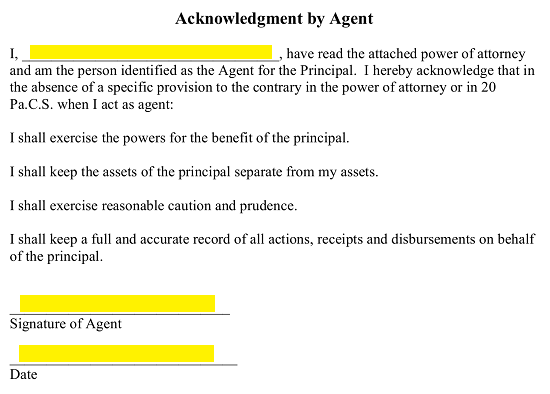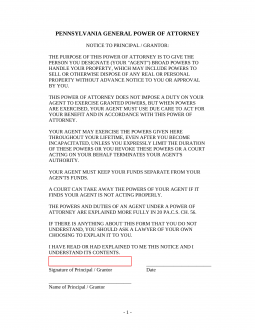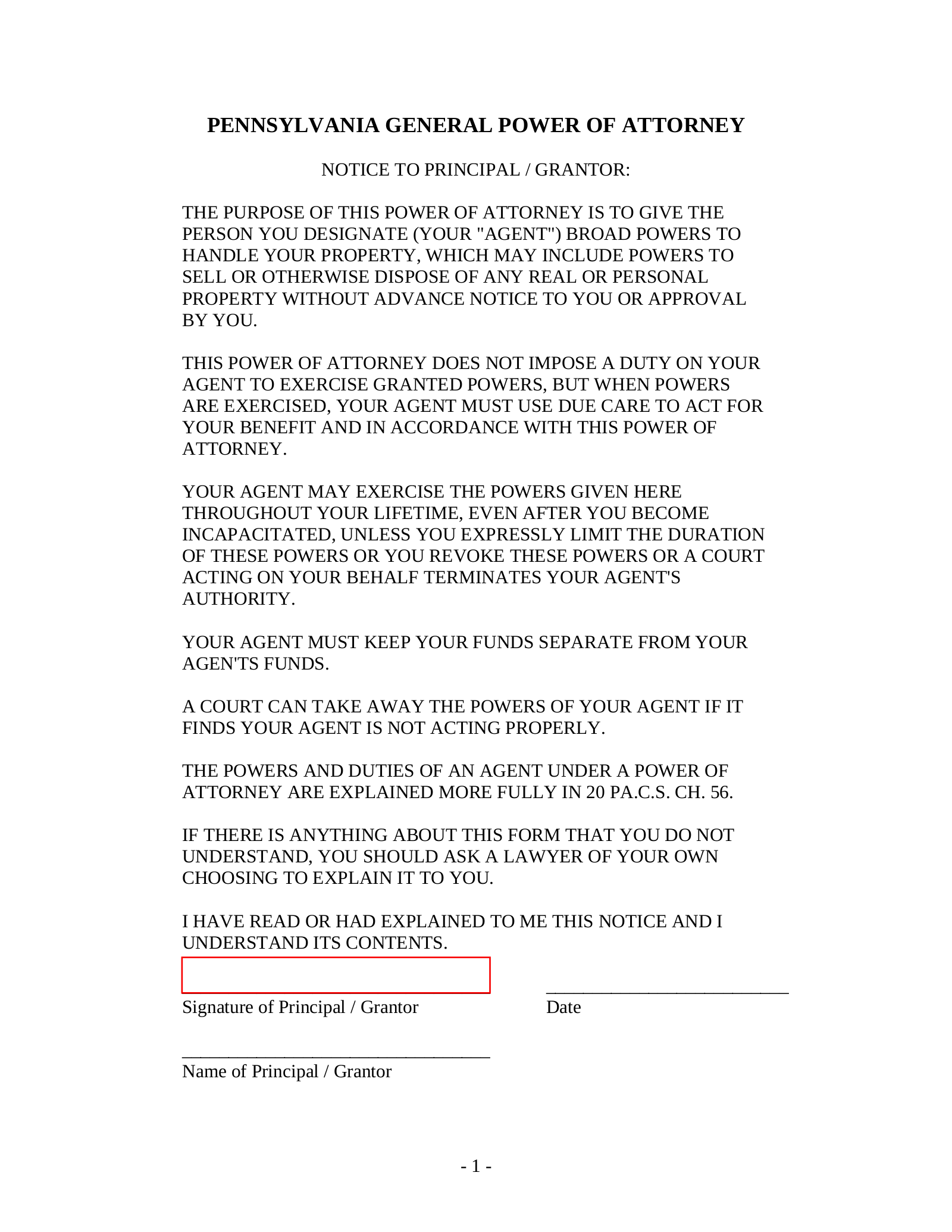Updated August 09, 2023
A Pennsylvania general (financial) power of attorney form provides a way in which you can legally appoint someone to stand in your place and act as your agent with regard to your assets and property. You can allow your agent to buy and sell your assets, open accounts, create trusts and do other things related to your finances. The difference between the durable and general appointments of principal power is that the general power document does NOT remain in effect during your incapacity. It terminates upon your incapacity. If you are looking for a POA that remains in effect, you should consider using the Pennsylvania Durable Power Of Attorney.
Laws
- Statutes – Chapter 56: Powers of Attorney
- Authority (20 Pa. C.S.A. § 5601.4) – An agent under a power of attorney may act on behalf of the principal and exercise broad authority as granted by the agreement.
- Signing Requirements (20 Pa. C.S.A. § 5601) – Two (2) Witnesses and Notary Public.
How to Write
Download: PDF, MS Word, OpenDocument
1 – The Principal Must Acknowledge The Initial Disclosure
The first page of this document will present a Notice which the Principal should read. Once he or she has finished this task, the Principal or Grantor of these Powers should Sign and Print his or her Name then enter the current Date.
2 – The Grantor and Attorney-in-Fact Will Be Introduced In The First Paragraph
Since this document is a template, it will provide the language necessary to achieve the goal of naming an individual with another individual’s Principal Authority. However, each of these parties will need to be clearly defined so this document’s Effect is valid and verifiable as such. This paragraph’s first required piece of information will be the Grantor’s Full Legal Name. This is the individual who will be known as a Principal and will empower another individual with the same Authority he or she carries in the matters discussed here. Naturally, since we have identified the Grantor by name, we will need to further this definition with an Address. On the second blank space in this paragraph, input the Grantor’s Complete Address.
Naturally, since we have identified the Grantor by name, we will need to further this definition with an Address. On the second blank space in this paragraph, input the Grantor’s Complete Address. The Grantor of Power in this document, also known as the Principal, will be delivering his or her Authority to an Agent or Attorney-in-Fact. This party must also be identified for the purposes of this paperwork. Fill in the Principal Agent’s Legal Full Name on the third blank space in this paragraph.
The Grantor of Power in this document, also known as the Principal, will be delivering his or her Authority to an Agent or Attorney-in-Fact. This party must also be identified for the purposes of this paperwork. Fill in the Principal Agent’s Legal Full Name on the third blank space in this paragraph. This statement’s final request will be for the Agent or Attorney-in-Fact’s Complete Address. Place this in the final blank space of this paragraph.
This statement’s final request will be for the Agent or Attorney-in-Fact’s Complete Address. Place this in the final blank space of this paragraph.
3 – The Principal Must Review The Default Powers Delivered By This Document
This paperwork will list each Principal Power Grantors generally deliver to the Agent so that Agent may adequately represent the Principal or Grantor interests. There will be twenty-three listed which will cover the full gambit of areas in a Grantor or Principal’s life. The Principal should read through this list and (recommended) discuss with an appropriately experienced professional (i.e. an attorney). The Grantor retains full control of the Powers granted thus, if any are not appropriate and should be removed should be crossed out or simply deleted if you have the appropriate software. For instance, if the Principal Agent should not have the Principal Power to Authorize the Principal’s “Admission To A Medical, Nursing, Residential, Or Similar Facility…,” “To Authorize Surgical Procedures,” or “Make An Anatomical Gift” then you will need to strike out or delete Items 8, 9, and 23. By crossing out or removing these items the Agent will not be able to use Principal Power to perform such actions on behalf of the Principal.
4 – Several Statements Of Agent Activity Should Be Reviewed By The Principal
The next area will continue with defining the Principal Decisions and Actions an Agent may take, however, this list will go into slightly more depth in defining these default Principal Power. The Grantor (or Principal) will need to go over the paragraphs provided. Any that should not apply to the Agent’s Principal Powers must be crossed out or deleted before the time of signing. The first paragraph, “This General Power Of Attorney…” shall name the Powers granted here as being in Effect upon the Principal Signing until the Grantor is incapacitated or passes away. If the Principal has decided these Powers should remain in Effect even if he or she is incapable of making decisions, then you should strongly consider filling out a Durable Power of Attorney instead. The next paragraph will further define this one.
The first paragraph, “This General Power Of Attorney…” shall name the Powers granted here as being in Effect upon the Principal Signing until the Grantor is incapacitated or passes away. If the Principal has decided these Powers should remain in Effect even if he or she is incapable of making decisions, then you should strongly consider filling out a Durable Power of Attorney instead. The next paragraph will further define this one. The next paragraph, “My Agent Shall Be Entitled To Reimbursement,” allows the Agent to use Principal Power to gain Reimbursement or Compensation from the Principal or any reasonable expenses he or she accrues while representing the Grantor or Principal. You may withdraw this statement by crossing it out or deleting it altogether.
The next paragraph, “My Agent Shall Be Entitled To Reimbursement,” allows the Agent to use Principal Power to gain Reimbursement or Compensation from the Principal or any reasonable expenses he or she accrues while representing the Grantor or Principal. You may withdraw this statement by crossing it out or deleting it altogether. The statement beginning with the words “If So Requested By Myself Or Any Authorize Personal Representative…” shall hold the Agent or Attorney-in-Fact responsible for providing an account of funds he or she handled upon request. If the Principal does not wish to include this, he or she may cross this statement out.
The statement beginning with the words “If So Requested By Myself Or Any Authorize Personal Representative…” shall hold the Agent or Attorney-in-Fact responsible for providing an account of funds he or she handled upon request. If the Principal does not wish to include this, he or she may cross this statement out. The next paragraph, starting with the words “This Power Of Attorney Shall Be Construed…” shall hold that if any part of this document is not lawful and thus ineffectual, the rest of the Powers or parts of this document will remain in effect. If the Principal wishes the entire document to become invalid once part of it is held illegal (i.e. in a case where the laws have changed), then delete or strike through this statement.
The next paragraph, starting with the words “This Power Of Attorney Shall Be Construed…” shall hold that if any part of this document is not lawful and thus ineffectual, the rest of the Powers or parts of this document will remain in effect. If the Principal wishes the entire document to become invalid once part of it is held illegal (i.e. in a case where the laws have changed), then delete or strike through this statement. The sixth paragraph shall declare this document outside the questioning of third parties. If the Principal does not wish this statement included in the way these Principal Powers operate then it should be removed or struck through with horizontal lines.
The sixth paragraph shall declare this document outside the questioning of third parties. If the Principal does not wish this statement included in the way these Principal Powers operate then it should be removed or struck through with horizontal lines. If the Principal has set these Powers so they are not taxable to the Agent, life insurance policies on the Principal are restricted from the Agent, and the Principal’s assets are outside of the General Powers granted then allow the seventh paragraph to remain. If this statement does not apply to the Principal Powers set here then it should be deleted or crossed out.
If the Principal has set these Powers so they are not taxable to the Agent, life insurance policies on the Principal are restricted from the Agent, and the Principal’s assets are outside of the General Powers granted then allow the seventh paragraph to remain. If this statement does not apply to the Principal Powers set here then it should be deleted or crossed out. The paragraph beginning with the sentence “Any Third Party Who Receives A Copy Of This Document May Act Under It” will release an Agent from liability of acting on this Authority if it has been revoked and that Third Party has not received the Revocation at the time of honoring the document. This paragraph, generally, is a standard term and should remain intact however, the Principal has ultimate control over the contents of this document.
The paragraph beginning with the sentence “Any Third Party Who Receives A Copy Of This Document May Act Under It” will release an Agent from liability of acting on this Authority if it has been revoked and that Third Party has not received the Revocation at the time of honoring the document. This paragraph, generally, is a standard term and should remain intact however, the Principal has ultimate control over the contents of this document. The last paragraph will release the Agent from holding from being held liable for making bad decisions so long as they were made in good faith. This does not absolve the Agent from being held responsible for his or her Fiduciary Duties or any misconduct.
The last paragraph will release the Agent from holding from being held liable for making bad decisions so long as they were made in good faith. This does not absolve the Agent from being held responsible for his or her Fiduciary Duties or any misconduct.
5 – The Grantor’s Signature Is The Executing Tool For This Paperwork
The Grantor’s Signature will need to be supplied to this paperwork, by the Grantor, in a proper manner so that it may execute the terms of this document. That is, it must be Dated, Witnessed, and Notarized. To begin the Principal should enter the Calendar Date when he or she signs this completed template on the first blank line after the words “Signed On.” Then on the second blank space, he or she must supply the Pennsylvania City where he or she is signing this paperwork. The Grantor or Principal must sign his or her Name on the line labeled “Signature Of Principal”
The Grantor or Principal must sign his or her Name on the line labeled “Signature Of Principal” Below the Principal Signature and to the right, each of the two Witnesses must sign one “Witness Signature” line, then record his or her Name and Address in print.
Below the Principal Signature and to the right, each of the two Witnesses must sign one “Witness Signature” line, then record his or her Name and Address in print. The portion of this document directly after the Witness Signatures will necessitate the participation of the Notary Public viewing the Principal Signing. Only a Notary Public can officially notarize the Principal’s Signing.
The portion of this document directly after the Witness Signatures will necessitate the participation of the Notary Public viewing the Principal Signing. Only a Notary Public can officially notarize the Principal’s Signing. The final section “Acknowledgment By Agent” will only need the Name of the Agent recorded on the first blank line (exactly as it was reported earlier). The Agent must read this statement then provide verification that he or she agrees with it by singing the line labeled “Signature Of Agent.” Below his or her Signature, the Date when he or she signed this document must be supplied by the Agent on the line labeled “Date.”
The final section “Acknowledgment By Agent” will only need the Name of the Agent recorded on the first blank line (exactly as it was reported earlier). The Agent must read this statement then provide verification that he or she agrees with it by singing the line labeled “Signature Of Agent.” Below his or her Signature, the Date when he or she signed this document must be supplied by the Agent on the line labeled “Date.”


